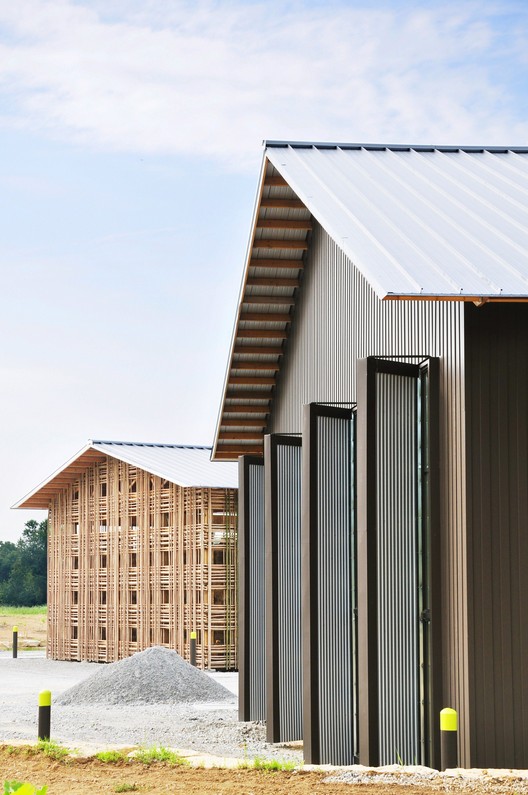
-
Architects: De Leon & Primmer Architecture Workshop
- Year: 2009
-
Photographs:Roberto de Leon
-
Manufacturers: 84 Lumber, Acuity Brands, Daltile, Dropseed Nursery, Homasote, Lichtefeld, Lithonia Lighting, Marmoleum, Marvin, Metal Sales Manufacturing Corp., Safecoat, U.S. Specialties, Woolford

Text description provided by the architects. The Mason Lane Farm Operations Facility is a new complex for farm equipment servicing, re-fueling & storage, as well as providing seasonal storage for grain & hay. The facility supports a 2,000-acre property utilized for agriculture, recreation, wildlife habitat and conservation purposes. The project has been submitted for LEED Gold Level certification and is notable as the first of its type for implementing LEED criteria to an agricultural project. More photographs and drawings following the break.

Rooted in the simplicity of regional farm structures and in concert with the client’s priorities for responsible stewardship of the land, the farm complex utilizes simple, passive sustainable approaches that are specifically based on an understanding of the regional climate and the nuances of the landscape. For reasons of both economy and ease of maintenance, sustainable building strategies are decidedly ‘low-tech’, favoring conventional construction methods & ordinary materials over specialized systems. In particular, the project implements strategies that take advantage of the cross-synergies between site & building design, focusing on a holistic approach where both components work as a single integrated system.

Consolidating the various programmatic elements into two large barn buildings and a grain silo (in order to minimize building footprints), the majority of the project site is allocated to the circulation & access requirements of large-scale farm equipment. Because facility water usage is minimal and site landscaping is limited to native & regionally-adapted plants that do not require irrigation, site-wide stormwater strategies focus on returning runoff to replenish local aquifers. Porous, drivable gravel surfaces are pitched to channel stormwater into two ‘rain gardens’ planted with native vegetation. Excess run-off is collected within these basins and allowed to percolate back into the groundwater table. In order to minimize maintenance, building roof gutters are eliminated and replaced with ‘site gutters’, a system of drivable, shallow concrete channel swales aligned below each roof eave, which direct stormwater to the collection basins.


The two primary buildings (Barn ‘A’ and Barn ‘B’) are arranged to frame an outdoor work courtyard, allowing for the consolidation of outdoor lighting requirements to an internalized site zone and away from the farm complex property perimeter, preserving ‘dark sky’ conditions.
Barn ‘A’, with fully enclosed storage & work areas, utilizes a standard prefabricated wood truss frame clad with corrugated metal panels. Emphasizing the layering of construction, building elements that are typically hidden (such as wall substrates, fastening screws & alignment lines) are incorporated as design features and reinterpreted as ‘finish’ materials. Natural light, ventilation and views are provided to all interior spaces through full-height operable windows which working in concert with a whole-house fan to draw air through the building.

Barn ‘B’, a large covered shed used to store both hay & equipment, is clad in a lattice grid of locally-harvested bamboo sourced only 35 miles from the project site. Considered a fast-growing invasive ‘weed’, the bamboo is a material nod to the square-bale hay that is stacked at each end of the barn, while also providing a breathable skin that allows the hay to dry through natural ventilation. Since Barn ‘B’ is an open-air structure vulnerable to wind-uplift forces, the concrete drainage channels below its roof eaves also function as a counterweight through an interlocking detail with the column concrete footings below grade.

Although the project is grounded primarily on passive heating & cooling strategies, several conventional mechanical approaches are used during extreme climate conditions like humid summer months. They include the following: In-slab hot-water coils heated with a wood-fired boiler (renewable energy source from onsite agriculture waste wood) with propane fuel back-up, whole-house ventilation fan, inverter-controlled ductless split system AC unit (a non-CFC-based refrigerant), florescent light fixtures on IR sensors & timers with manual override, low-flow toilet & low-volume water fixtures integrated to an adjacent septic field.

A particular focus on recycled and locally/regionally sourced materials informed the choice of construction systems and finishes. The primary building materials are comprised of the following: Building Construction : Pre-fabricated wood trusses, pressure-treated wood framing, high fly-ash concrete slab on grade with insulation/drainage board containing 40% recycled content, concrete piers, prefinished corrugated metal panels (siding & roof) with 49% recycled content, locally harvested bamboo, galvanized wire ties, insulated glazing (fixed & operable windows), wire-glass.
Finish Materials : Pressure-treated 2x wood planks, phenol-formaldeyde (versus urea-based) OSB, low-formaldehyde emissions (non-urea based) MDF, Homasote (98% post-consumer waste paper-fiber panels; tackable & sound-absorbent), wood screws, linoleum tiles. Landscaping: Zero-irrigation native and regionally-adapted plants, locally-sourced decomposed granite aggregate (gravel), local limestone (retaining walls), rain gardens (stormwater retention basins).





































